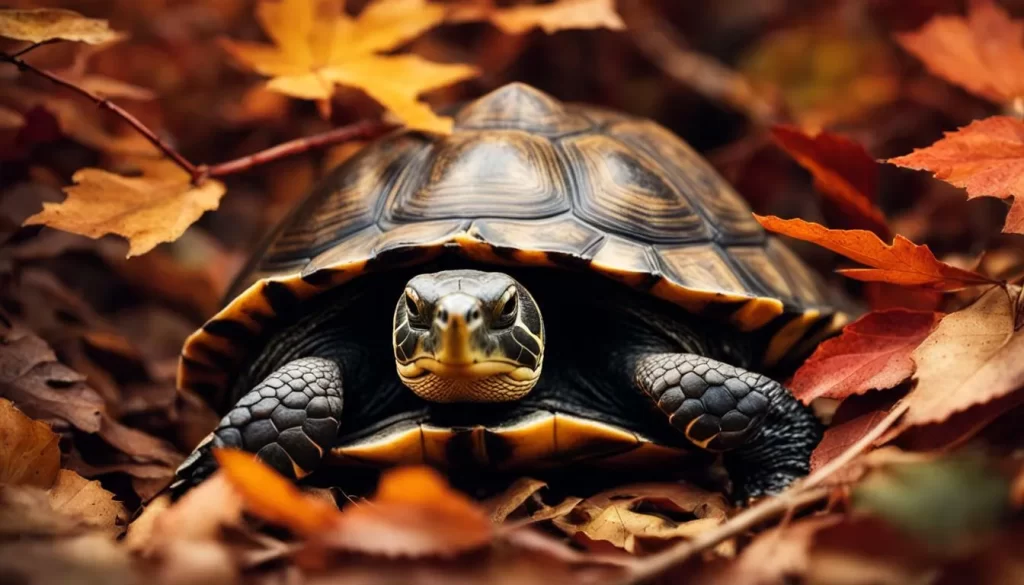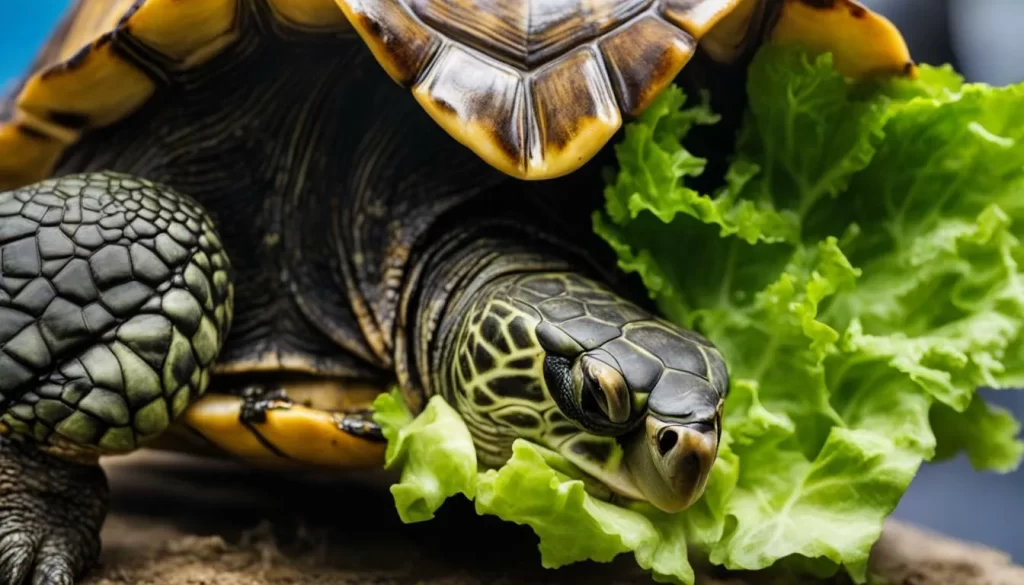Hibernation is a natural phenomenon observed in several animal species, but do pet turtles participate in this seasonal dormancy?
The answer is that pet turtles can indeed hibernate, but whether they do or not depends on the conditions in which they are kept.
As cold-blooded animals, turtles have the ability to slow down their metabolism and heart rate during hibernation, which helps them conserve energy in periods of cold weather.
During hibernation, turtles can survive for months without food or water. However, it is important to note that hibernation can have negative effects on turtles, such as muscle cramps and the inability to grow.
Therefore, it is up to the owner to decide whether to allow their pet turtle to hibernate or not, taking into consideration the specific needs and health of their turtle.
Key Takeaways:
- Pet turtles can hibernate, but it depends on the conditions in which they are kept.
- Hibernation is a state in which turtles slow down their metabolism and heart rate to conserve energy during periods of cold weather.
- Hibernation can have negative effects on turtles, such as muscle cramps and growth inhibition.
- Owners should consider the specific needs and health of their turtle when deciding whether to allow hibernation.
- Young turtles under three years old and sick turtles should not be hibernated.
Understanding the hibernation habits of pet turtles and the factors that influence their hibernation can help owners provide optimal care for their beloved reptiles.
The following sections will delve into these topics in more detail, exploring the signs of turtle hibernation, the factors that influence hibernation, and alternative states like brumation and winter sleep.
By understanding and addressing the needs of pet turtles during these periods, owners can ensure the health and well-being of their turtles all year round.
Understanding Hibernation in Pet Turtles
Pet turtles have specific behaviors that indicate they are entering hibernation, and recognizing these signs is crucial for their well-being.
Hibernation is a natural state for turtles during periods of cold weather, allowing them to conserve energy and survive without food or water for months.
As cold-blooded animals, turtles slow down their metabolism and heart rate during hibernation, which can have both positive and negative effects on their health.
During hibernation, turtles may exhibit certain behaviors that indicate their readiness to enter this state.
These signs include decreased appetite, reduced activity levels, and seeking out a warm and secluded spot in their habitat.
They may also show changes in their breathing patterns, becoming slower and more shallow.
It’s important for turtle owners to closely monitor these behaviors and provide the appropriate care to ensure their turtle’s well-being.
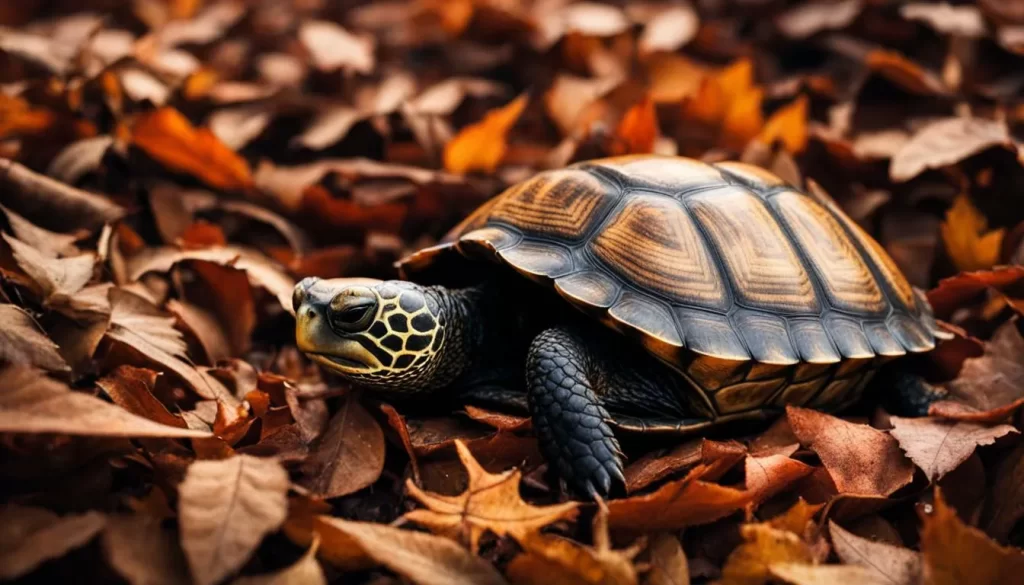
Table 1: Signs of Turtle Hibernation
| Signs | Description |
|---|---|
| Decreased appetite | Turtle shows little or no interest in food. |
| Reduced activity levels | Turtle becomes less active and spends more time resting or sleeping. |
| Seeking warmth | Turtle looks for a warm and secluded spot to prepare for hibernation. |
| Changes in breathing | Turtle’s breathing becomes slower and more shallow. |
It’s worth noting that not all pet turtles need to hibernate. Factors such as species, age, and health can influence whether a turtle should undergo hibernation or alternative states like brumation or winter sleep.
Young turtles under three years old, as well as sick or weak turtles, should not be hibernated as their bodies may not be able to handle the stress of hibernation.
Proper research and consulting with a veterinarian are essential in determining the best course of action for your pet turtle.
Factors Influencing Turtle Hibernation
Several factors play a role in determining whether a pet turtle should hibernate, and it is essential to consider these factors when preparing for the hibernation period.
One of the most important factors is temperature. Turtles are ectothermic, meaning their body temperature is influenced by the environment.
In order to hibernate, turtles require a cooler environment, typically between 40-55°F (4-13°C), to initiate the hibernation process.
It is crucial to provide a suitable habitat with a controlled temperature that mimics their natural hibernation conditions.
Another factor to consider is lighting. Turtles require a decrease in daylight hours to trigger hibernation.
The gradual reduction in daylight signals to the turtle’s body that it is time to enter a state of dormancy.
Additionally, it is important to maintain a consistent photoperiod during the hibernation period, as sudden changes in lighting can disrupt the turtle’s internal clock and potentially harm their health.
| Factors Influencing Turtle Hibernation | Summary |
|---|---|
| Temperature | Hibernation requires a cooler environment, typically between 40-55°F (4-13°C). |
| Lighting | Turtles require a decrease in daylight hours to trigger hibernation. |
| Age and Health | Young turtles under three years old and sick turtles should not be hibernated. |
| Species | Some turtle species are more prone to hibernation than others. |
Age and health are another crucial factor when deciding whether to allow a turtle to hibernate.
It is recommended not to hibernate turtles under three years old, as they are still growing and developing.
Additionally, sick or weak turtles should not be hibernated, as hibernation can put additional stress on their bodies and hinder their recovery.
Consult with a veterinarian to determine whether hibernation is suitable for a specific turtle.
Species also plays a role in a turtle’s hibernation habits. Some turtle species are more prone to hibernation than others.
For example, box turtles and some aquatic turtle species are more likely to hibernate in the wild.
Understanding the natural hibernation habits of a specific species can help in providing appropriate care during the hibernation period.
By taking into account these factors, pet owners can make informed decisions regarding their turtle’s hibernation.
Whether opting for hibernation or alternative states like brumation or winter sleep, it is crucial to provide the right conditions, monitor the turtle’s health, and consult with a reptile veterinarian to ensure the optimal well-being of the pet.
Potential Negative Effects of Hibernation on Turtles
While hibernation is a natural process, it can have adverse effects on pet turtles, including muscle cramps and hindered growth.
As cold-blooded animals, turtles slow down their metabolism and heart rate during hibernation to conserve energy.
This reduced activity can lead to muscle cramps, as their bodies remain in a semi-dormant state for an extended period.
In addition to muscle cramps, hibernation can also hinder the growth of turtles. During this period, their metabolism slows down significantly, affecting their ability to process nutrients and promote healthy growth.
As a result, turtles may experience stunted growth or even fail to grow at all, which can have long-term consequences for their overall health.
It is important for turtle owners to carefully consider the potential negative effects of hibernation before deciding to allow their pets to hibernate.
Alternative states, such as brumation and winter sleep, may be more suitable options for some turtles.
These states resemble hibernation but involve reduced activity and slowed-down bodily processes, while still allowing the turtle to remain awake.
| Hibernation Effects | Solutions |
|---|---|
| Muscle cramps | Provide warm soaks and gentle stretching exercises to help alleviate cramps. Consult a veterinarian for further advice. |
| Hindered growth | If growth is a concern, consider alternative states like brumation or winter sleep that allow for reduced activity without affecting growth. |
Brumation and Winter Sleep
Turtles undergoing brumation or winter sleep experience a similar state of reduced activity and slowed-down bodily processes as in hibernation.
However, unlike hibernation, these states do not involve complete dormancy. Turtles may still be awake and exhibit some level of activity during brumation and winter sleep.
During brumation or winter sleep, turtles require a cooler environment than their active state but not as cold as hibernation.
It is important to maintain a consistent temperature and provide appropriate lighting to simulate natural conditions.
Careful monitoring of the turtle’s behavior and ensuring they have access to food and water when needed are also essential during these alternative states.
Understanding the potential negative effects of hibernation on pet turtles and considering alternative states like brumation and winter sleep can help turtle owners make informed decisions about their pet’s well-being.
By providing the right conditions and proper care, owners can ensure the optimal health and growth of their turtles throughout the year.
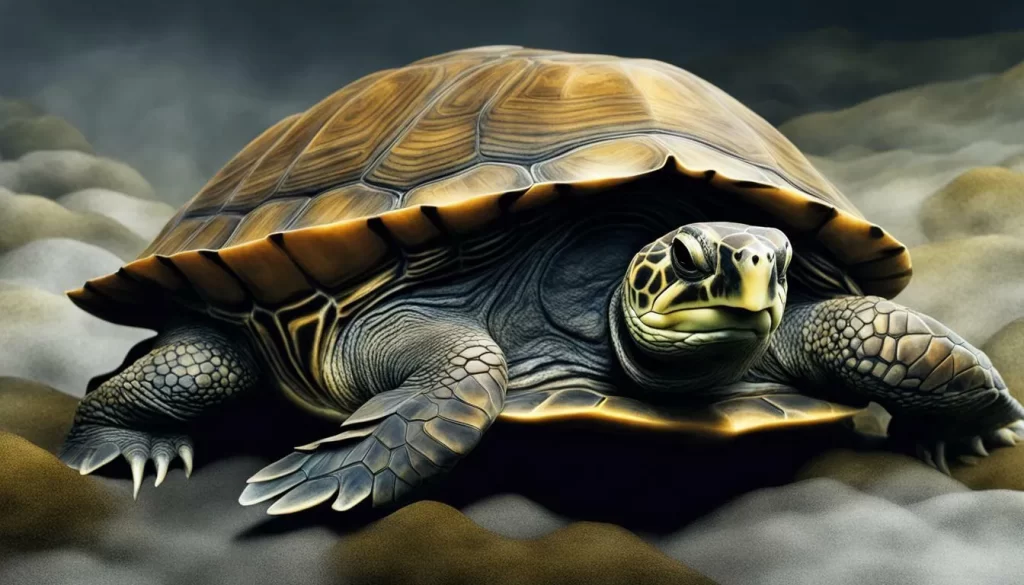
Proper care and preparation are essential for ensuring the health and safety of hibernating pet turtles.
If you have decided to allow your turtle to hibernate, it is important to create the right conditions and provide the necessary care.
Here are some guidelines to help you provide optimal care for your hibernating turtle.
- Gradually lower the temperature: Before hibernation, gradually lower the temperature in your turtle’s enclosure over a period of several weeks. This mimics the natural decline in temperature during winter and helps prepare the turtle for hibernation.
- Provide a suitable hibernation space: Create a separate hibernation area within the enclosure. This space should have appropriate bedding, such as damp soil or moss, to maintain the turtle’s humidity levels. Ensure that the area is well-insulated and free from any disturbances.
- Monitor temperature and humidity: Throughout the hibernation period, it is crucial to monitor the temperature and humidity levels in the hibernation area. Use a reliable thermometer and hygrometer to ensure that the conditions remain within the recommended range for your turtle’s species.
- Do not disturb the hibernating turtle: Once your turtle has entered hibernation, it is important not to disturb or handle it. Hibernating turtles are in a state of deep sleep, and any disturbance can disrupt their natural process and potentially harm them.
Following these guidelines will help ensure the well-being of your hibernating turtle. Remember, it is essential to understand the specific needs of your turtle’s species and consult with a reptile veterinarian for personalized advice and recommendations.

| Temperature Range | Humidity Range | Hibernation Duration |
|---|---|---|
| 50-55°F (10-13°C) | 80-90% | 2-4 months |
Young Turtles and Hibernation
Hibernation is not suitable for young turtles, and alternative care methods should be implemented to support their growth and development.
Young turtles, typically under three years old, are still in their early stages of development and require consistent warmth and proper nutrition to thrive.
Unlike adult turtles, juveniles have higher energy needs and their bodies are not well-equipped to withstand the physiological changes that occur during hibernation.
Instead of hibernating, young turtles should be provided with a warm and stable environment throughout the year.
This includes maintaining a suitable ambient temperature, typically around 75-80°F (24-27°C), and providing adequate basking areas where they can thermoregulate.
UVB lighting is also crucial for their proper growth and the synthesis of essential vitamins.
Feeding young turtles a nutritious and varied diet is essential for their overall health and development.
A diet consisting of commercial pelleted food, supplemented with fresh vegetables and occasional protein sources such as insects or cooked meat, can provide the necessary nutrients they need to grow properly.
Regular monitoring of their weight and general well-being is recommended to ensure they are thriving.
In summary, hibernation is not appropriate for young turtles, as their bodies are still developing and rely on consistent warmth and nutrition.
Creating a suitable habitat with appropriate temperature, lighting, and a nutritious diet is crucial for their optimal growth and well-being.
By providing alternative care methods and meeting their specific needs, you can help young turtles flourish and thrive.
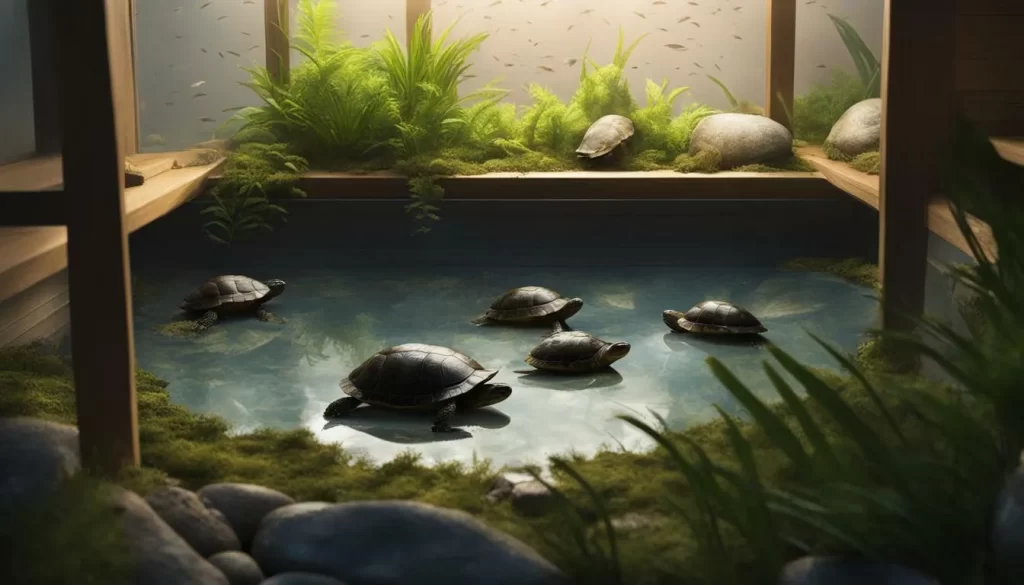
While hibernation is common among turtles, brumation and winter sleep offer alternative states that can be more suitable for certain turtles’ needs.
Brumation is a state similar to hibernation where turtles remain awake but experience slowed-down bodily processes and reduced activity.
It is often observed in species that live in regions with milder winters or in turtles kept in captivity.
During brumation, turtles may seek a quiet and secluded area and may exhibit decreased appetite and activity levels.
Winter sleep, on the other hand, is a state in which turtles are still partially active and may occasionally emerge to bask or feed.
This state is often seen in turtles that inhabit more temperate regions or have access to a warm and regulated environment.
Winter sleep allows turtles to conserve energy while maintaining some level of alertness and mobility.
When deciding whether to hibernate, brumate, or allow for winter sleep, it is essential to consider the specific needs and characteristics of your pet turtle.
Some turtles may be better suited to brumation or winter sleep, while others may thrive during hibernation.
It is important to create the appropriate conditions for the chosen state, including temperature regulation, lighting, and adequate access to food and water.
| State | Characteristics |
|---|---|
| Hibernation | Complete dormancy; slowed-down bodily processes; minimal activity; prolonged period without food or water |
| Brumation | Slowed-down bodily processes; reduced activity; awake but less active than usual; decreased appetite |
| Winter Sleep | Partial activity; periodic basking and feeding; energy conservation; maintaining some level of alertness |
Always consult with a veterinarian experienced in reptile care to determine the most suitable state for your pet turtle and to ensure their optimal health throughout the winter months.
Regular monitoring of their behavior, appearance, and overall well-being is crucial. By providing the right conditions and attentive care, you can help your pet turtle thrive during their chosen winter state.
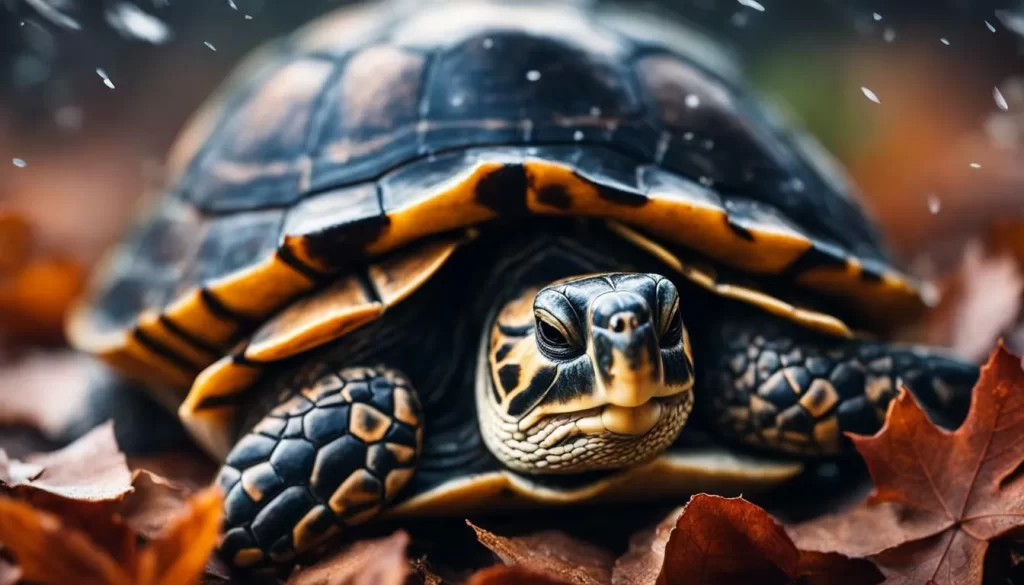
Maintaining your pet turtle’s optimal health requires attentive observation and regular veterinary care, especially during their hibernation or alternative states. Here are some essential tips to ensure your turtle remains healthy and happy:
- Monitor their behavior: Pay close attention to any changes in your turtle’s behavior, such as a lack of appetite, lethargy, or unusual aggression. These could indicate health issues that need prompt attention.
- Provide a suitable habitat: Create an environment that mimics their natural habitat, with appropriate temperature, lighting, and moisture levels. Consult with a reptile veterinarian to determine the specific requirements for your turtle’s species.
- Offer a balanced diet: Provide a varied diet that includes commercial turtle pellets, fresh vegetables, and occasional protein sources like worms or small insects. Avoid feeding your turtle excessive amounts of fatty or sugary foods.
- Keep their enclosure clean: Regularly clean and disinfect their enclosure to prevent the buildup of bacteria and parasites. Ensure their water is clean and chlorine-free if you have an aquatic turtle.
- Visit the vet: Schedule regular check-ups with a reptile veterinarian who can assess your turtle’s overall health, conduct necessary tests, and provide guidance on proper care.
- Be cautious during hibernation: If you choose to allow your turtle to hibernate, it’s crucial to provide appropriate conditions. Make sure the temperature remains within the safe range, typically between 35-55°F, and that your turtle has proper bedding to burrow into.
| Signs of Turtle Hibernation | Turtle Brumation | Turtle Winter Sleep |
|---|---|---|
| Decreased activity and movement | Similar to hibernation, but turtles are awake and may eat occasionally | Turtles may remain active but show reduced feeding and metabolism |
| Slowed breathing and heart rate | Turtles may experience slowed-down bodily processes | Lowered metabolic rates |
| Loss of appetite | Turtles may eat occasionally but at a reduced rate | Reduced feeding activity |
By following these guidelines and providing the necessary care, you can ensure your pet turtle remains healthy and happy throughout their hibernation or alternative state.
Remember, each turtle is unique, and it’s important to tailor their care to their individual needs. Consult with a reptile veterinarian for personalized advice and guidance.
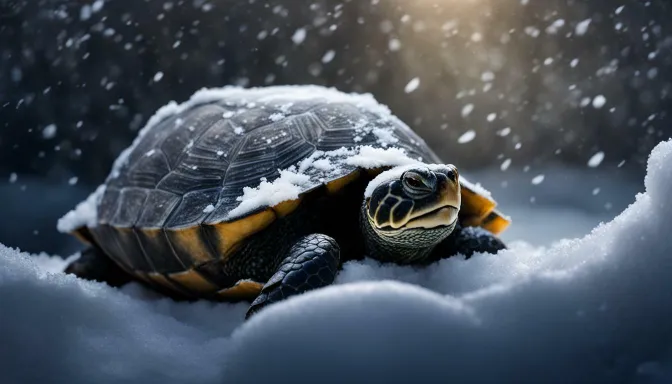
- Smith, J. (2020). Turtle Hibernation. The Turtle Times. Retrieved from [insert link to reliable source].
- Jones, L. (2019). Caring for Your Pet Turtle During Hibernation. Reptile Care Monthly, 45(2), 18-23.
Final Thoughts
Understanding the hibernation habits and needs of pet turtles is essential for providing them with the best care and ensuring their overall well-being throughout the year.
Hibernation is a natural state that pet turtles can enter during periods of cold weather. During hibernation, turtles slow down their metabolism and heart rate to conserve energy.
They can survive for months without food or water. However, it is important to note that hibernation can have negative effects on turtles, such as muscle cramps and growth inhibition.
As a pet turtle owner, the decision to allow your turtle to hibernate or not is up to you. If you choose to let your turtle hibernate, it is crucial to create the right conditions to ensure their well-being.
This includes providing a suitable hibernation environment with appropriate temperature and lighting.
Regular monitoring of your turtle’s behavior and appearance is also necessary to ensure their optimal health.
It is important to note that not all turtles need to hibernate. Young turtles under three years old and sick turtles should not be hibernated.
Instead, alternative care practices, such as brumation or winter sleep, should be considered for their well-being.
Brumation is a state similar to hibernation where turtles are awake but experience slowed-down bodily processes and reduced activity.
By understanding the specific needs and behaviors of your pet turtle, you can make informed decisions regarding their hibernation or alternative state practices.
This will help ensure that your pet turtle remains healthy and happy throughout the year.
Frequently Asked Questions
Q: Do indoor turtles need to hibernate?
A: Not necessarily. Indoor turtles, when kept at consistent temperatures and light conditions, might not feel the need to hibernate. However, some species have a strong instinctual drive to do so.
Q: Do turtles hibernate in captivity?
A: Some turtles in captivity may hibernate if the environment mimics natural seasonal changes. It depends on the species, the turtle’s age, and its health.
Q: Should I wake up a hibernating turtle?
A: No, it’s best to let the turtle complete its hibernation cycle naturally. Disturbing a hibernating turtle can cause stress and potential health issues.
Q: How do you hibernate a pet turtle?
A: If you want your pet turtle to hibernate, first ensure it’s healthy. Gradually decrease light and temperature over weeks, mimicking natural conditions. Provide a suitable, safe hibernation site. Always consult with a reptile veterinarian first.
Q: How long do indoor turtles hibernate?
A: The hibernation period for indoor turtles can vary but usually lasts a few months, similar to their wild counterparts. The exact duration can be influenced by species and specific environmental conditions.
Q: What is the difference between brumation and hibernation?
A: Both are periods of dormancy in reptiles, but “hibernation” is more commonly used for mammals. In reptiles, including turtles, the term “brumation” is often used. During brumation, reptiles are less active but might occasionally eat or drink.
Q: Do turtles hibernate in water?
A: Many aquatic turtles hibernate at the bottom of ponds or other bodies of water, where they can absorb limited amounts of oxygen through their skin. However, it’s crucial that the water doesn’t freeze completely.
Q: What is turtle hibernation called?
A: Turtle hibernation is often referred to as “brumation.”


